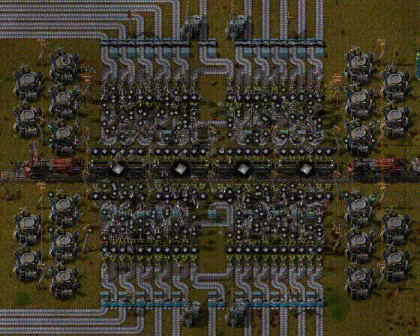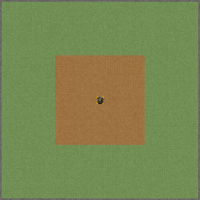游客你好,登录后能编辑wiki哦!
物流网络
阅读
2020-08-21更新
最新编辑:逗比的马老师
阅读:
更新日期:2020-08-21
最新编辑:逗比的马老师

物流网络是一系列不同的物流仓库和物流机器人,它们全部被一个或多个相连的机器人平台覆盖。
机器人会根据箱子的类型和配置以及物流网络的区域,在这些箱子之间运输物品,这是替代手动或通过传送带或铁路。 但是,机器人具有更高的移动性,因为它们可以在直线上越过障碍物飞越。
The player character can also act as requester chest in the logistic network, allowing them to 'request' various items be kept at a set limit within their personal inventory. After researching Character logistic slots, they can configure an amount of items; and logistic robots will start to move the specified items from the network to the character's inventory.
物品
| Entity | Description |
|---|---|
| 机器人指令平台 | Central component of the logistic network in which the robots operate. Roboport coverage defines the area of the logistic network. Robots need to periodically return here to recharge. |
| 物流机器人 | Moves items between logistic chests.1 |
| 建设机器人 | Repairs broken or replaces destroyed entities. Builds, deconstructs and upgrades entities on command. |
| 主动供货箱 (紫箱) | Logistic chest: Pushes stored items into the logistic network.2 |
| 被动供货箱 (红箱) | Logistic chest: Places stored items at the logistic network's disposal.2 |
| 被动存货箱 (黄箱) | Logistic chest: Stores items currently not requested. Can be filtered to only store one type of item. Supplies stored items to the Logistic network.2 |
| 优先集货箱 (蓝箱) | Logistic chest: Will be filled by logistic robots until the configured amount is reached, or the chest becomes full. Can request multiple different types of items.2 |
| 主动存货箱 (绿箱) | Logistic chest: Functions as both a requester chest and passive provider chest.2 |
(1) Default capacity is 1 item per robot. This can be increased by researching Worker robot cargo size (research).
(2) Logistic chests can also be connected to the circuit network with red wire or green wire.
Usage
To start with, just use passive provider- and requester chests. Place the passive provider chests at the output inserters of assembling machines and requester chests at the input (let them request the needed items). Place a roboport, which covers these chests with the inner orange area. Place some logistic bots in the roboport. The robots will fly out of the top hatch and will begin to work. You can now limit the number of produced item with the stack limitation-feature.
The logistic network makes it possible to create complex items in a relatively small factory area, but its throughput is limited by how many robot charge points (roboports) exist in the network.
The basic thing needed for item transportation is roboports. The roboport shows the orange logistic coverage and the green construction coverage when held in the cursor or hovered after placing.
- The orange zone is the logistic network coverage. This is also the maximum distance for connecting two roboports.
- The green zone is the construction area.
Expanding the logistic network
There can be many separate logistic networks. Two roboports are in the same network only if they are connected, so if their logistic areas are touching. Visually this is represented by a dashed yellow line connecting them. To prevent roboports from linking, the player needs to build them far enough away from each other so that the orange zones don't touch.
Bots do not fly migrate from one network to another, unless their home network is destroyed in some way, for example when all roboports are removed or out of power.
Mechanics
Losing bots
Worker robots are a priority target of biters, and the enemies will prioritize attacking them over many objects in the vicinity of the robots.
Robots may run out of charge on longer journeys which will reduce their flying speed to 20% of their normal speed. Robots that run out of charge will fly to the closest recharge point instead of their original target. This means that they may depart from the original route and even go into the opposite direction, depending on where the closest charging point is.
When the charging-queue for the bots gets too long, the bots (and their loads) will slow down. Generally, a roboport can charge between 50 and 70 bots per min, 4 at a time, but are not very efficient at charging large queues of bots and can quickly become overworked.
Negative numbers
It is possible to notice negative numbers on the 'Logistic Network'-Screen when looking at network storage or opening the logistic networks GUI the with 模板:Keybinding.
The logistic network numbers report items in provider and storage chests, minus the amount of items scheduled to be picked up by robots. When negative numbers are shown, it means that more items are being requested than are available in the network. There is a deficit. This can be a problem, or intended, depending on the player's choice. The negative value is just to explain why items aren't being delivered. For example, a deficit of 20 iron plates would look like this:
Receiving more items than requested
The delivered number of items in the requester chest can be higher than requested. This depends on the researched Worker robot cargo size-bonus, since bots will always take as much as they can carry if an unlimited amount is available.
Choosing the post for charging
Normally a robot flies to the nearest roboport to recharge. If the queue on that roboport is too long, they eventually choose another port. This is specified by the ratio of <distance to different roboport in tiles> / <queue size of robots waiting>.
Currently, to choose the more distant roboport, the distance must be at most <Number of robots in the queue and on the way> / 2. So, to choose a roboport that is 10 tiles more distant, it has to have 20 less robots waiting in the queue.
Priorities of robots
This overview reflects the priorities in which order the chests are filled/emptied.
Logistic robots on the logistic network look for orders by the chests in this order:
- A requested item is first looked up in active provider chests and in the player's trash slots, then in the storage chests and buffer chests, then the passive provider chests. So, the active provider chests are emptied first, then the storage chests and buffer chests, then the passive provider chests.
- Requests are assigned first for player logistics, then for requester chests, then for buffer chests.
| Source Priority | > > | Target Priority | 1 > > > 2 |
|---|
(1) Requesters with "request from buffer chests" have higher priority than others, the same as a player.
(2) Storage does not "request" items on its own. It receives actively discarded items from a) active providers, b) player trash slots, c) deconstruction, and d) robots that have their orders cancelled while carrying items. Storage is the last priority, and receives only items that have nowhere else to go.
- To place items into storage chests, the bots search for a storage chest that already stores items of the same type, then for one which has its filter set to the item type. If that can't be found, they choose the first storage chest with a free slot from the list, which is sorted by the order they were built in. [1] This is to avoid having storage chests with different items inside, allowing greater organisation.
Distance
When looking to pick up requested items from multiple chests of equal priority, bots will always choose the closest one. [2]
This is however only true when an item is being requested, not when an item is sent away via player trash slots or active provider chests. In the case of items being sent into the logistics network, distance does not matter, instead when chests have the same priority, for example two active provider chests, the bots will alternate between the chests in a round-robin fashion.
相关成就

|
快递上门 使用物流机器人为自己运送物品。 |

|
快递砸破门 使用物流机器人为自己运送物品一万个 (10k) 。 |

|
传送带神教的狂热教徒 不铺设主动供货箱 (紫箱)、主动存货箱 (绿箱)和优先集货箱 (蓝箱)通关游戏。 |



 沪公网安备 31011002002714 号
沪公网安备 31011002002714 号